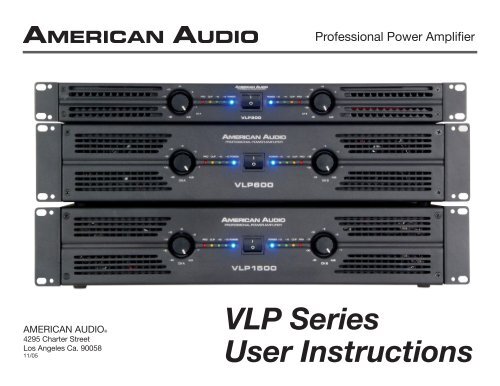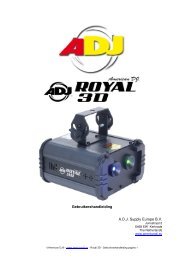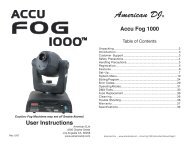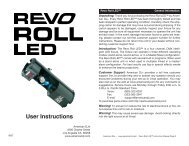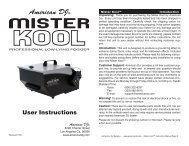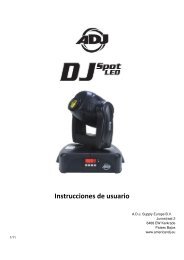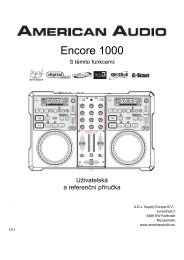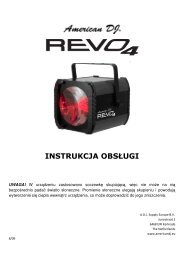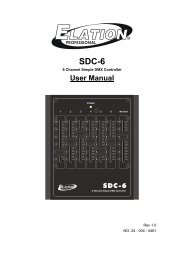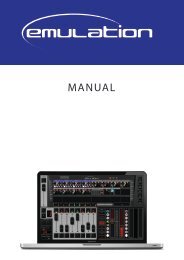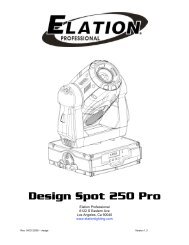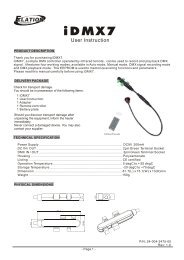Manual for American Audio VLP-1500 Power Amplifier
Manual for American Audio VLP-1500 Power Amplifier
Manual for American Audio VLP-1500 Power Amplifier
You also want an ePaper? Increase the reach of your titles
YUMPU automatically turns print PDFs into web optimized ePapers that Google loves.
AMERICAN AUDIO®<br />
4295 Charter Street<br />
Los Angeles Ca. 90058<br />
11/05<br />
Professional <strong>Power</strong> <strong>Amplifier</strong><br />
<strong>VLP</strong> Series<br />
User Instructions
This symbol is intended to alert the user to the presence of non insulated "dangerous voltage" within the product's enclosure that may be of sufficient magnitude to<br />
constitute a risk of electric shock to persons.<br />
This symbol is intended to alert the user of the presence of important operating and maintenance (servicing) instructions in the literature accompanying the product.<br />
CAUTION: Risk of the electrical shock - DO NOT OPEN!<br />
CAUTION: To reduce the risk of electrical shock, do not remove cover. No user serviceable parts inside. Refer all servicing to qualified service personnel.<br />
WARNING: To prevent electrical shock or fire hazard, do not expose this amplifier to rain or moisture. Be<strong>for</strong>e using this amplifier, read the user manual <strong>for</strong> further warnings.<br />
Este símbolo tiene el propósito de alertar al usuario de la presencia de “voltaje peligroso“ que no tiene aislamiento dentro de la caja del producto que puede tener<br />
una magnitud suficiente como para constituir riesgo de corrientazo.<br />
Este símbolo tiene el propósito de alertar al usuario de la presencia de instrucciones importantes sobre la operación y mantenimiento en la literatura que vienc con<br />
el producto.<br />
PRECAUCIÓN: Riesgo del choque eléctrico - NO SE ABRA<br />
PRECAUCIÓN: Para disminuir el riesgo de choque eléctrico, no quite la cubierta. No hay piezas adentro que el usario puede reparar. Deje todo mantenimiento al los técnicos<br />
cualificados.<br />
ADVERTENCIA: Para prevenir choque eléctrico o riesgo de incendios, no deja expuesto a la lluvia o a la humedad este amplificador. Antes de usar este amplificador, lea<br />
mas advertencias en la guia de operacion.<br />
Ce symbole est utilisé pur indiquer à l’utilisateur la présence à l'intérieur de ce produit de tension non-isolée dangereuse pouvant être d'intensité suffisante pour<br />
constituer un risque de choc électrique.<br />
Ce symbole est utilisé pour indiquer à l’utilisateur qu'il trouvera d'importantes instructions importantes sur l'utilisation et l'entretien de l'appareil dans la littérature<br />
accompagnant le produit.<br />
ATTENTION: Risque de choc électrique - NE PAS OUVRIR!<br />
ATTENTION: Afin de réduire le risque de choc électrique, ne pas enlever le couvercle. Il ne se trouve à l’intérieur aucune piéce pouvant être réparée par l'utilisateur. Confier<br />
l'entretien à un personnel qualifié.<br />
AVERTISSEMENT: Afin de prévenir les risque de décharge ou de feu, n’exposez pas cet appareil à la pluie ou à l’humidité. Avant d’utiliser cet amplificateur, lisez les avertissements<br />
supplémentaries situés dans le guide.<br />
Dieses Symobl soll den Anwender vor unisollierten gefährlichen Spannungen innerhalb des Gehäuses warnen, die von Ausreichender Stärke sind, um einen elektrischen<br />
Schlag verursachen zu können.<br />
Dieses Symobl soll den Benutzer auf wichtige Instruktionen in der Bedienungsanleitung aufmerksam machen, die Handhabung und Wartung des Produkts betreffen.<br />
VORSICHT: Risiko - Elektrischer Schlag! Nicht öffnen!<br />
VORSICHT: Um ddas Risiko eines elektrischen Schlages zu vermeiden, nicht die Abdeckung enfernen. Es befinden sich keine Teile darin, die vom Anwender repariert<br />
werden könnten. Reparaturen nur von qualifizierte Fachpersonal durchführen lassen.<br />
ACHTUNG: Um einen elektrischen Schlag oder Feuergefahr zu vermeiden, sollte diesen Gerät nicht dem Regen oder Feuchtigkeit ausgesetz werden. Vor Inbetriebnahme<br />
unbedingt die Bedienungsanleitung lesen.<br />
©<strong>American</strong> <strong>Audio</strong>® - www.americanaudio.com - <strong>VLP</strong> Series <strong>Power</strong> <strong>Amplifier</strong> User <strong>Manual</strong> Page 2
CAUTION<br />
Do not open -<br />
risk of electric shock<br />
CAUTION: TO REDUCE THE RISK OF ELECTRIC<br />
SHOCK, DO NOT REMOVE THE COVER.<br />
THERE ARE NO USER SERVICEABLE PARTS<br />
INSIDE. REFER ALL SERVICE TO YOUR<br />
AUTHORIZED AMERICAN AUDIO® DEALER.<br />
The lightning flash with an arrow triangular<br />
symbol is intended to alert the user to the<br />
presence of non insulated “dangerous voltage”<br />
within the products enclosure, and<br />
may be of sufficient magnitude to constitute<br />
a risk of electric shock.<br />
The exclamation point triangular symbol is<br />
intended to alert the user to the presence<br />
of important operating and maintenance<br />
(servicing) instructions in the user manual<br />
accompanying the amplifier.<br />
FOR OPTIMUM PERFORMANCE AND<br />
RELIABILITY DO NOT PRESENT THE<br />
AMPLIFIER WITH A SPEAKER LOAD<br />
OF LESS THAN 2 OHMS OR ANY<br />
COMBINATION OF SPEAKERS THAT<br />
TOGETHER ARE LESS THAN 2 OHMS!<br />
USING ONE SPEAKER, IT MUST BE<br />
RATED AT 4 OR MORE OHMS.<br />
USING TWO SPEAKERS, THEY MUST<br />
RATED EACH AT 4 OR MORE OHMS.<br />
USING THREE SPEAKERS, THEY<br />
MUST BE RATED EACH AT 8 OR MORE<br />
OHMS.<br />
P O U R A S S U R E R L A F I A B I L E T E E T<br />
OBTENIT UNE PERFORMANCE OPTIMALE,<br />
NESOUMETTE JAMAIS L’AMPLIFICATEUR<br />
A UNE CHARGE D’IMPEDANCE TOTALE<br />
INFERIEURE A 2 OHMS, NI AVEC UN H.P. NI<br />
EN COMBINAISON DES H.P.<br />
AVEC UN H.P., IL FAUT UNE CHARGE<br />
D’IMPEDANCE MINIMUM DE 2 OHMS.<br />
AVEC DEUX H.P., FAUT POUR CHAOUN UNE<br />
CHARGE D’IMPEDANCE MINIMUM DE 4<br />
OHMS.<br />
AVEC TROIS H.P., FAUT POUR CHAOUN UNE<br />
CHURGE D’IMPEDANCE MINIMUM DE 8<br />
OHMS.<br />
CONTENTS:<br />
Safety Precautions.......................................................................................................................................................................................4<br />
Introduction...............................................................................................................................................................................................4<br />
Front Panels.................................................................................................................................................................................................5<br />
Rear Panels..................................................................................................................................................................................................7<br />
Inputs...........................................................................................................................................................................................................9<br />
Outputs............................................................................................................................................................................................................9<br />
Speakon Output Connector Assembly.......................................................................................................................................................11<br />
Operating Modes........................................................................................................................................................................................12<br />
Protection Circuitry<br />
Limiter.................................................................................................................................................................................................13<br />
Short Circuit Protection...................................................................................................................................................................13<br />
Thermal Protection..........................................................................................................................................................................14<br />
<strong>Amplifier</strong> Features.......................................................................................................................................................................................14<br />
Speaker Setup............................................................................................................................................................................................15<br />
Warranty.................................................................................................................................................................................................16<br />
Specifications...............................................................................................................................................................................................17<br />
©<strong>American</strong> <strong>Audio</strong>® - www.americanaudio.com - <strong>VLP</strong> Series <strong>Power</strong> <strong>Amplifier</strong> User <strong>Manual</strong> Page 3
Important Precautions<br />
• To reduce the risk of electrical shock or fire, do not expose this<br />
unit rain or moisture.<br />
• Do not spill water or other liquids into or on to your unit.<br />
• Do not attempt to operate this unit if the power cord has been<br />
frayed or broken.<br />
• Do not attempt to remove or break off the ground prong from<br />
the electrical cord. This prong is used to reduce the risk of elec-<br />
trical shock and fire in case of an internal short.<br />
• Disconnect main power be<strong>for</strong>e making any type of connection<br />
• Do not remove the cover under any conditions. There are no<br />
user serviceable parts inside.<br />
• Never plug this unit in to a dimmer pack.<br />
• Always be sure to mount this unit in an area that will allow<br />
proper ventilation. Allow about 6” (15cm) between this device<br />
and a wall.<br />
• Do not attempt to operate this unit, if it becomes damaged.<br />
• This unit is intended <strong>for</strong> indoor use only, use of this product outdoors<br />
voids all warranties.<br />
• During long periods of non-use, disconnect the unit’s main<br />
power.<br />
• Always mount this unit in a safe and stable manner.<br />
• <strong>Power</strong> cords should be routed so they are not likely to be<br />
walked on, pinched by items placed upon or against them.<br />
• Cleaning -The outside of the unit should be wipe down with a<br />
soft cloth and mild cleaner when needed.<br />
• Heat -The appliance should be situated away from heat sources<br />
such as radiators, heat registers, stoves, or other appliances<br />
(including amplifiers) that produce heat.<br />
• The fixture should be serviced by qualified service personnel<br />
when:<br />
A. The power-supply cord or the plug has been damaged.<br />
B. Objects have fallen on, or liquid has been spilled into the unit.<br />
C. The appliance has been exposed to rain or water.<br />
D. The fixture does not appear to operate normally or exhibits a<br />
marked change in per<strong>for</strong>mance.<br />
Introduction<br />
Introduction: Congratulations and thank you <strong>for</strong> purchasing<br />
this <strong>American</strong> <strong>Audio</strong>® <strong>VLP</strong> series amplifier. This amplifier is a<br />
representation of <strong>American</strong> <strong>Audio</strong>’s continuing commitment to<br />
produce the best and highest quality products all at an af<strong>for</strong>dable<br />
price. Please read and understand this manual completely be<strong>for</strong>e<br />
attempting to operate your new amplifier. This booklet contains<br />
important in<strong>for</strong>mation concerning the proper and safe operation of<br />
your new amplifier.<br />
Unpacking: Every <strong>VLP</strong> Series amplifier has been thoroughly<br />
tested and has been shipped in perfect operating condition.<br />
Carefully check the shipping carton <strong>for</strong> damage that may have<br />
occurred during shipping. If the carton appears to be damaged,<br />
carefully inspect your unit <strong>for</strong> any damage and be sure all accessories<br />
necessary to operate the unit has arrived intact. In the event<br />
damage has been found or parts are missing, please contact our<br />
toll free customer support number <strong>for</strong> further instructions. Please<br />
do not return the amplifier to your dealer without contacting customer<br />
support first.<br />
Installation: This amplifier is designed to mount into a standard<br />
19” rack. The front panel provides four holes used to screw the<br />
unit into a rack. The unit also provides a way to rear mount the<br />
unit into a rack <strong>for</strong> added security. Rear mounting the unit is especially<br />
recommended <strong>for</strong> this amplifier if the unit is to mounted into<br />
a mobile rack.<br />
Customer Support: <strong>American</strong> <strong>Audio</strong>® provides a toll free customer<br />
support line, to provide set up help and to answer any question<br />
should you encounter problems during your set up or initial operation.<br />
You may also visit us on the web at www.americanaudio.com<br />
<strong>for</strong> any comments or suggestions. For service related issue please<br />
contact <strong>American</strong> <strong>Audio</strong>®. Service Hours are Monday through<br />
Friday 9:00 a.m. to 5:00 p.m. Pacific Standard Time.<br />
Voice: (800) 322-6337 E-mail: support@americanaudio.com<br />
Fax: (323) 582-2610<br />
©<strong>American</strong> <strong>Audio</strong>® - www.americanaudio.com - <strong>VLP</strong> Series <strong>Power</strong> <strong>Amplifier</strong> User <strong>Manual</strong> Page 4
Front Panel<br />
<strong>VLP</strong>600 & <strong>VLP</strong><strong>1500</strong><br />
30<br />
10<br />
80<br />
6<br />
CH A<br />
0 dB<br />
3<br />
1<br />
PROFESSIONAL POWER AMPLIFIER<br />
15 PRO CLIP 10 15 POWER<br />
POWER 15 10 CLIP PRO 15<br />
1. Channel 1 Gain Control - This rotary knob is used to control the output<br />
signal of channel one. Turning the knob in a clockwise direction will<br />
increase signal output.<br />
2. Channel 1 Protect Indicator - The red Protect LED will begin to glow<br />
when the channel goes into protect mode. When the channel goes into<br />
protect mode all output <strong>for</strong> that channel will turn off. This is to protect any<br />
speakers connected to the channel.<br />
3. Channel 1 Clip Indicator - This red LED will begin to flash when<br />
channel one begins to overload (clip). At this point channel one will begin<br />
to distort. Under heavy clipping activity lower the channel one gain<br />
control to reduce the risk of damage to your speakers and amplifier. This<br />
LED may glow when the unit has been turned off, this is normal.<br />
4. Channel 1 Signal Indicators - These green and yellow LED’s will glow<br />
according to the average signal output.<br />
5. Function Indicators - These indicators detail the operating mode of<br />
the amplifier. These LEDs will also function as a power indicator.<br />
6. <strong>Power</strong> Switch - This switch is used to control the units main power.<br />
7. Channel 2 Signal Indicators - These green and yellow LED’s will glow<br />
according to the average signal output.<br />
8. Channel 2 Clip Indicator - This red LED will begin to flash when<br />
channel one begins to overload (clip). At this point channel one will begin<br />
to distort. Under heavy clipping activity lower the channel one gain<br />
1 2 3 4 5 6 5<br />
7 8 9 10<br />
<strong>VLP</strong><strong>1500</strong><br />
30<br />
10<br />
6<br />
80<br />
0 dB<br />
CH B<br />
©<strong>American</strong> <strong>Audio</strong>® - www.americanaudio.com - <strong>VLP</strong> Series <strong>Power</strong> <strong>Amplifier</strong> User <strong>Manual</strong> Page 5<br />
3<br />
1<br />
Figure 1<br />
control to reduce the risk of damage to your speakers and amplifier. This<br />
LED may glow when the unit has been turned off, this is normal.<br />
9. Channel 2 Protect Indicator - The red Protect LED will begin to glow<br />
when the channel goes into protect mode. When the channel goes into<br />
protect mode all output <strong>for</strong> that channel will turn off. This is to protect any<br />
speakers connected to the channel.<br />
10. Channel 2 Gain Control - This rotary knob is used to control the<br />
output signal of channel two. Turning the knob in a clockwise direction<br />
will increase signal output.
Front Panel<br />
<strong>VLP</strong>300<br />
10<br />
6<br />
PROFESSIONAL POWER AMPLIFIER<br />
15 PRO CLIP 10 15 POWER<br />
POWER 15 10 CLIP PRO<br />
11. Channel 1 Gain Control - This rotary knob is used to control the<br />
output signal of channel one. Turning the knob in a clockwise direction<br />
will increase signal output.<br />
12. Channel 1 Protect Indicator - The red Protect LED will begin to<br />
glow when the channel goes into protect mode. When the channel goes<br />
into protect mode all output <strong>for</strong> that channel will turn off. This is to protect<br />
any speakers connected to the channel.<br />
13. Channel 1 Clip Indicator - This red LED will begin to flash when<br />
channel one begins to overload (clip). At this point channel one will begin<br />
to distort. Under heavy clipping activity lower the channel one gain<br />
control to reduce the risk of damage to your speakers and amplifier. This<br />
LED may glow when the unit has been turned off, this is normal.<br />
14. Channel 1 Signal Indicators - These green and yellow LED’s will<br />
glow according to the average signal output.<br />
15. <strong>Power</strong> Indicators - These LEDs function as a power indicator.<br />
16. <strong>Power</strong> Switch - This switch is used to control the units main power.<br />
17. Channel 2 Signal Indicators - These green and yellow LED’s will<br />
glow according to the average signal output.<br />
30<br />
80<br />
11 12 13 14 15 16 15 17 18 19 20<br />
0 dB<br />
3<br />
1<br />
CH A<br />
<strong>VLP</strong>300<br />
18. Channel 2 Clip Indicator - This red LED will begin to flash when<br />
channel one begins to overload (clip). At this point channel one will begin<br />
to distort. Under heavy clipping activity lower the channel one gain<br />
control to reduce the risk of damage to your speakers and amplifier. This<br />
©<strong>American</strong> <strong>Audio</strong>® - www.americanaudio.com - <strong>VLP</strong> Series <strong>Power</strong> <strong>Amplifier</strong> User <strong>Manual</strong> Page 6<br />
30<br />
CH B<br />
15<br />
10<br />
80<br />
6<br />
0 dB<br />
3<br />
1<br />
Figure 2<br />
LED may glow when the unit has been turned off, this is normal.<br />
19. Channel 2 Protect Indicator - The red Protect LED will begin to<br />
glow when the channel goes into protect mode. When the channel goes<br />
into protect mode all output <strong>for</strong> that channel will turn off. This is to protect<br />
any speakers connected to the channel.<br />
20. Channel 2 Gain Control - This rotary knob is used to control the<br />
output signal of channel two. Turning the knob in a clockwise direction<br />
will increase signal output.
Rear Panel Control<br />
<strong>VLP</strong>600 & <strong>VLP</strong><strong>1500</strong><br />
26<br />
21. Cooling Fans - Dual high speed cooling fans<br />
21 22 23 24 25<br />
26 27 28<br />
21<br />
22. Channel 2 XLR Input - Channel two 3-pin XLR balanced input jack. See<br />
page 9 <strong>for</strong> more details.<br />
23. Channel 2 TRS Input - Channel two 1/4” female jack. Excepts either a balanced<br />
or unbalanced plug. See page 9 <strong>for</strong> more details.<br />
24. Mode Switch - This switch controls the amplifier’s operating mode. The<br />
amplifier can operate in three different modes; Mono Bridge, Stereo, or Parallel<br />
Mono. The amplifier is shipped in stereo mode.<br />
25. Ground On/Off Switch - If hear a hum or any interference, put the Ground<br />
switch in the “On” postion .<br />
26. Channel 2 Speakon Output - Optional speaker output connections. Use<br />
pins 1+ and 1- of this 4-pole Speakon connector to connect to your speaker’s<br />
Speakon input jack.<br />
27. Channel 2 Output Jack/5 way Binding Post - Connect to your speaker’s<br />
input jack. Red is positive signal and Black is negative signal.<br />
28. AC Cord - Plug this cable into a standard wall outlet. Check that the voltage<br />
in your area matches the amplifiers required voltage.<br />
29. Fuse Holder - This housing stores a 15 amp GMA protective fuse <strong>for</strong> the<br />
<strong>VLP</strong> 600 and 30 amp GMA protective fuse <strong>for</strong> the <strong>VLP</strong> <strong>1500</strong>. Never defeat the<br />
fuse, the fuse is designed to protect the electronics in the event of severe power<br />
fluctuations. Always be sure to replace the fuse with an exact match as the one<br />
being replaced, unless otherwise told to do so by an authorized <strong>American</strong> <strong>Audio</strong>®<br />
service technician.<br />
35<br />
34 33 32 31<br />
30 29<br />
Figure 3<br />
30. Channel 1 Output Jack/5 way Binding Post - Connect to your speaker’s<br />
input jack. Red is positive signal and Black is negative signal.<br />
31. Channel 1 Speakon Output - Optional speaker output connections. Use<br />
pins 1+ and 1- of this 4-pole Speakon connector to connect to your speaker’s<br />
Speakon input jack.<br />
32. Filter Switch - This switch controls the amplifier’s filter mode. The amplifier<br />
can operate in three different filter modes; High Pass, Low Pass, and By-Pass.<br />
33. Channel 1 TRS Input - Channel one 1/4” female jack. Excepts either a balanced<br />
or unbalanced plug. See page 9 <strong>for</strong> more details.<br />
34. Channel 1 XLR input - Channel one 3-pin XLR balanced input jack. See<br />
page 9 <strong>for</strong> more details.<br />
35. Limiter Switch - This is used to activate the channels built-in limiter. The<br />
limiter reduces the average input level when the signal begins to distort,<br />
this process is designed to reduce distortion and protect the speakers.<br />
See limiter page 13.<br />
©<strong>American</strong> <strong>Audio</strong>® - www.americanaudio.com - <strong>VLP</strong> Series <strong>Power</strong> <strong>Amplifier</strong> User <strong>Manual</strong> Page 7
Rear Panel Control<br />
36 37 38 39 40 41 42 43 44 45 46 47 48<br />
49<br />
50<br />
36. AC Cord - Plug this cable into a standard wall outlet. Check that the voltage<br />
in your area matches the amplifiers required voltage.<br />
37. Channel 1 TRS Input - Channel one 1/4” female jack. Excepts either a balanced<br />
or unbalanced plug. See page 9 <strong>for</strong> more details.<br />
38. Channel 1 XLR input - Channel one 3-pin XLR balanced input jack. See<br />
page 9 <strong>for</strong> more details.<br />
39. Mode Switch - This switch controls the amplifier’s operating mode. The<br />
amplifier can operate in three different modes; Mono Bridge, Parallel Mono, or<br />
Stereo. The amplifier is shipped in stereo mode.<br />
40. Channel 2 XLR Input - Channel two 3-pin XLR balanced input jack. See<br />
page 9 <strong>for</strong> more details.<br />
41. Channel 2 TRS Input - Channel two 1/4” female jack. Excepts either a balanced<br />
or unbalanced plug. See page 9 <strong>for</strong> more details.<br />
42. Filter Switch - This switch controls the amplifier’s filter mode. The amplifier<br />
can operate in three different filter modes; High Pass, Low Pass, and By-Pass.<br />
43. Ground On/Off Switch - If hear a hum or any interference, put the Ground<br />
switch in the “On” postion .<br />
45. Channel 2 Output Jack/5 way Binding Post - Connect to your speaker’s<br />
input jack. Red is positive signal and Black is negative signal.<br />
46. Channel 1 Output Jack/5 way Binding Post - Connect to your speaker’s<br />
input jack. Red is positive signal and Black is negative signal.<br />
pins 1+ and 1- of this 4-pole Speakon connector to connect to your speaker’s<br />
Speakon input jack.<br />
48. Channel 2 Speakon Output - Optional speaker output connections. Use<br />
pins 1+ and 1- of this 4-pole Speakon connector to connect to your speaker’s<br />
Speakon input jack.<br />
49. Cooling Fans - Dual high speed cooling fans<br />
50. Fuse Holder - This housing stores a 8 amp GMA protective fuse. Never<br />
defeat the fuse, the fuse is designed to protect the electronics in the event of<br />
severe power fluctuations. Always be sure to replace the fuse with an exact<br />
match as the one being replaced, unless otherwise told to do so by an authorized<br />
<strong>American</strong> <strong>Audio</strong>® service technician.<br />
47. Channel 1 Speakon Output - Optional speaker output connections. Use<br />
©<strong>American</strong> <strong>Audio</strong>® - www.americanaudio.com - <strong>VLP</strong> Series <strong>Power</strong> <strong>Amplifier</strong> User <strong>Manual</strong> Page 8<br />
Figure 4
Set Up<br />
INPUTS - The <strong>VLP</strong> Series amplifier allows you to use two types of input connector per a channel, a XLR jack <strong>for</strong> balanced connections<br />
and a 1/4” female jack that will accept balanced and unbalanced connectors. Use these connections to connect the output signal from<br />
a mixer, cross-over or EQ to your <strong>VLP</strong> Series amplifier. A balanced connection is recommended <strong>for</strong> cable runs longer that 20ft. When<br />
constructing your own XLR cables follow the pin configuration describe below <strong>for</strong> proper connections. For cable runs shorter than<br />
20ft. you may choose the 1/4” unbalanced input option. The 1/4” unbalanced input option may be more convenient <strong>for</strong> most users<br />
due to the abundant supply of prefabricated cables available at your local audio dealer. You may use the two XLR “Input Thru” jacks<br />
to jump a parallel connection to another amplifier or other device. For Example: Connect a XLR cable to the input of channel one. You<br />
may now connect a XLR cable from the channel one “Input Thru” jack to the input jack of another amplifier’s channel one input. This<br />
will reduce the use of “Y” cables.<br />
Male XLR Pin Confi guration:<br />
US ITT Standard<br />
OUTPUTS:<br />
2<br />
3<br />
2 Hot (+ data) 1 Ground/Return/ 0v)<br />
3 Negative (- data)<br />
1<br />
Diagram 5<br />
Balanced TRS 1/4” Plug<br />
Hot (+) Ground/Shield<br />
Negative (-)<br />
Diagram 6<br />
Binding Post/Banana Plug - Connect your speakers to the binding post outputs on the rear of the amplifier. The<br />
speaker wire may be connect by bare wire (directly connected, usually <strong>for</strong> permanent connections), banana plug,<br />
or spade connector. Connections are made to Channels 1 and 2 output’s <strong>for</strong> stereo mode or across the red terminals<br />
of Channels 1 and 2 <strong>for</strong> Mono Bridge Mode.<br />
Important Notice: Although a speaker will operate with the positive and negative leads plugged into either terminal<br />
on the amplifier binding post, be sure to plug the negative lead into the black terminal and positive lead<br />
into the red terminal. Ensuring proper polarity will avoid speakers being out of phase, that can cause a loss of<br />
Figure 8<br />
bass response.<br />
Important Notice: Banana Plugs - When connecting your speakers to the amplifier using banana jacks; Be sure that the red and black<br />
caps on the binding post are completely screwed in. Insert the banana jacks into the caps of the binding post, be sure that the banana<br />
jack is inserted securely to avoid the risk of it popping out.<br />
©<strong>American</strong> <strong>Audio</strong>® - www.americanaudio.com - <strong>VLP</strong> Series <strong>Power</strong> <strong>Amplifier</strong> User <strong>Manual</strong> Page 9<br />
Unbalanced TS 1/4” Plug<br />
Hot (+)<br />
Negative (-)<br />
Diagram 7
Bare Wire Connections: (Figure 9)<br />
When connecting your speakers to the amplifier using bare wire; Unscrew the red and<br />
black caps on the binding post, be sure not to completely remove or unscrew the red<br />
and black caps. Strip back the wire insulation 1/2” (13mm). Insert the bare wire into the<br />
hole that was reveled by unscrewing the binding post cap. After inserting the wire into<br />
the binding post hole, screw the binding post cap down on the wire. To reduce the risk of<br />
shock or damage to your amplifier, be sure that the wire connected to one binding post<br />
does not come in contact with that of another. Typical speaker output using bare wire. Insert<br />
Spade Connector: (Figure 10)<br />
When connecting your speakers to the amplifier using spade connector; Unscrew the red and black caps on<br />
the binding post, be sure not to completely remove or unscrew the red and black caps. Insert the spade connector<br />
in to the binding post and tighten the caps down on the spade connector. To reduce the risk of shock<br />
or damage to your amplifier, be sure that the wire connected to one binding post does not come in contact<br />
with that of another.<br />
When connecting your speakers to the amplifier using banana jacks; Be sure that the red and black caps on<br />
the binding post are tighten down completely. Insert the banana jacks into the caps of the binding post, be<br />
sure that the banana jack is inserted securely to avoid the risk of it popping out.<br />
Mono Bridge Connections:<br />
Mono bridge operation connections will follow the above descriptions however, when operating in mono<br />
bridge operation the speaker connections will run between the two positive (red) leads. Use channel two positive<br />
output terminal <strong>for</strong> the negative connection and the channel one positive output terminal <strong>for</strong> the positive<br />
connection.<br />
Stereo Connections Using the Neutrik Speakon output connectors:<br />
Figure 10<br />
Typical speaker output using<br />
spade connectors. Insert<br />
bare wire into the binding<br />
post and tighten.<br />
Recent regulatory requirements in Europe have outlawed the use of the dual banana plug and <strong>for</strong>ce amp users to terminate their speaker<br />
cables with spade lugs or bare wire ends. This is not advantageous to most users that want to reconfigure their systems or quickly<br />
change out an amp. The Neutrik Speakon® connector provides the most convenient solution to this problem, eliminating the need <strong>for</strong><br />
spade plugs or bare wire end cables. Major speaker manufacturers have been using Speakon connectors on their products <strong>for</strong> years,<br />
so chances are you are ready to use the Speakon connection. With Speakon connectors, you can connect straight from the amplifier<br />
to the speaker. The Speakon connector used on this amplifier meets all known safety regulations. Once wired correctly, the connector<br />
cannot be plugged in backwards, causing the type of inverted polarity situations that have become common with banana hookups. This<br />
connection will provide a safe, secure and reliable method of connecting your speakers to your new amplifier. You can purchase the<br />
Speakon® NL4FC connectors from your local audio dealer.<br />
©<strong>American</strong> <strong>Audio</strong>® - www.americanaudio.com - <strong>VLP</strong> Series <strong>Power</strong> <strong>Amplifier</strong> User <strong>Manual</strong> Page 10<br />
Figure 9<br />
bare wire into the binding post and tighten.
SPEAKON ASSEMBLY: You will need a pair of Neutrik Speakon® NL4FC<br />
connectors. You will also need high-quality two or four conductor speaker<br />
cable, a pair of needle-nosed pliers and a 1.5-mm Allen key to assemble the<br />
Speakon connectors to your speaker wire. To assemble the Neutrik Speakon<br />
NL4FC connector, complete the following steps:<br />
1. Strip back 3/4-inch of the cable casing. Strip off 1/4-inch from the end of<br />
each of the conductors down to bare wire, and insert the brass fittings. See<br />
Figure 11.<br />
2. Slide the cable tension clip (D) and the speakon coupler (E) through the<br />
cable end. See Figure 12.<br />
3. Insert each wire with the brass fittings into the top of appropriate slot of the<br />
connector insert (B) as shown in Figures 12 and 13. Use a 1.5-mm Allen key<br />
to tighten the connection. See Figure 13.<br />
4. Be sure to properly match the positive (+) and negative (–) leads of each<br />
wire. See Figure 14.<br />
5. Slide the connector insert (B) into the connector housing (A), making sure<br />
that the large notch on the outer edge of the insert lines up with the large<br />
groove on the inside of the connector housing. The insert should slide easily<br />
through the housing and out the other side until it extends approximately 3<br />
/4-inch from the end of the housing.<br />
6. Slide the cable tension clip (D) along the cable and insert into the housing<br />
(A), making sure that the large notch lines up with the large groove on the<br />
inside of the connector housing (A). The cable tension clip (D) should slide<br />
easily into the housing until only 3 /8-inch of the cable tension clip (D) extends<br />
from the back end of the connector.<br />
7. Slide the coupler (E) along the cable and screw it onto the end of the<br />
housing (A). Be<strong>for</strong>e tightening, you may want to test the connector to make<br />
sure it has been assembled properly.<br />
Figure 11<br />
Figure 12<br />
Figure 13<br />
Figure 14<br />
Brass Inserts<br />
A B C<br />
©<strong>American</strong> <strong>Audio</strong>® - www.americanaudio.com - <strong>VLP</strong> Series <strong>Power</strong> <strong>Amplifier</strong> User <strong>Manual</strong> Page 11<br />
+1<br />
-1<br />
+<br />
+2<br />
+2<br />
C 2 C 1<br />
UTPUTS<br />
INPUT BANCE<br />
SPEAKON 1+ HOT<br />
1 COLD<br />
4-Conductor Speaker Cable<br />
INPUT TU<br />
CAUTION<br />
MINIMUM LOAD IMPEDANCE 2 OHM PERCHANNEL 4 OHM BRIDGE<br />
- B ID E +<br />
N<br />
C 2<br />
- +- +<br />
-1<br />
+1<br />
D E<br />
C 1<br />
120 60<br />
4800 ATTS<br />
+2<br />
+2<br />
+
OPERATING MODES: Always configure your amplifier operating mode be<strong>for</strong>e beginning operation. If you want to change it during<br />
per<strong>for</strong>mance. You must decrease the gain controls to their lowest levels to protect the speakers from any popping noise.<br />
Stereo Operation - Page 15/Figure 15 details an example of a typical stereo set-up. Connect your inputs into channels one and<br />
two of the amplifier. Connect your speakers to the outputs on the rear of the amplifier. Be sure that your front gain controls are turned<br />
down to their lowest level (full counter-clockwise). Turn your amp on. Turn your input source level up. Use your front gain controls to<br />
regulate the output volume. Be sure not to raise the volume to the clip level, however an intermittent clip signal is acceptable.<br />
Mono Bridge Operation - Page 15/Figure 16 details a mono bridge set-up. Be sure your amplifier and all other audio equipment<br />
is powered down. Flip the Stereo/Mono Bridge switch to the Mono Bridge position. Connect an input signal to channel one. Connect<br />
your speaker across the red output binding post on the rear of your amplifier. Turn your equipment on (your amplifier should always<br />
be the last item you turn on). Apply an input source signal to your amplifier. Turn channel two gain up. Use the channel one gain to<br />
regulate your amplifier output.<br />
Bridged-Mono Mode Caution - The voltage across the output terminals of a bridged <strong>VLP</strong> Series amplifier may equal or exceed<br />
100 volts RMS and may be as high as 130 volts. Use fully insulated CLASS ONE wiring, and the load must be rated <strong>for</strong> up to 2500 watts<br />
(@4 ohms)<br />
Parallel Mono - “Parallel ” ties the two channel line inputs together so that they will both be driven by the same signal, without the<br />
need <strong>for</strong> external jumpers or wiring. Both amplifier channels will operate independently. Though they carry the same signal, their gain<br />
controls affect only their respective channels, and they both must use their respected speaker outputs. Never attempt to parallel the<br />
speaker outputs, this may cause serious damage to your amplifier! This mode is recommended when using the <strong>VLP</strong> Series to run bass<br />
speakers, to achieve better low end. To run in parallel mono mode connect your system as you would if you were going to run in stereo<br />
mode. Then flip the mode switch to “MONO.” Be sure the amp is off or the power is disconnected be<strong>for</strong>e making any changes.<br />
©<strong>American</strong> <strong>Audio</strong>® - www.americanaudio.com - <strong>VLP</strong> Series <strong>Power</strong> <strong>Amplifier</strong> User <strong>Manual</strong> Page 12
Mono Subwoofer - This operation is similar to the Stereo Subwoofer operation but in mono. When running subwoofers it is usually<br />
recommended to run them in mono mode to achieve a cleaner tighter low end. This operation allows you to run several subwoofers<br />
down to a minimum of 4 ohms. To avoid amplifier overheating, never run the amplifier below 8 ohms in this mode. Set up this mode<br />
as you would a standard stereo set up. Be sure both channels are set to “SUBWOOF” and the mode switch is set to “MONO.” In this<br />
mode you may use the frequency adjustment on the rear of the amp, to control the bass frequency output level. Frequencies may be<br />
adjusted from 20Hz to 200Hz.<br />
One Channel Normal/One Channel Subwoofer (BI-AMP) - You may also use your amp to bi-amp your system. You may use one<br />
side of the amp to power a subwoofer and the other side to power a full range speaker. Follow the set up guides listed above to mix<br />
and match your operations.<br />
PROTECTION:<br />
Limiter - Only the <strong>VLP</strong> <strong>1500</strong> and 600 come with a built in limiter. When the input signal overloads, the “CLIP LED’s” indicate a signal<br />
overload, at this time, the master volume should be lowered to reduce distortion. If the input gain level is not reduced the built-in<br />
limiter will activate. During signal overload, the limiter will reduce the input audio signal enough to minimize the amount of clipping.<br />
A limiter takes the gain of an overloading signal and reduces it, the reduction in gain reduces distortion that can cause damage to<br />
your speakers and amplifier. During normal operation below clipping, and momentary clips on peaks, the limiter does not affect the<br />
audio signal and is inaudible. It will allow brief clipping of peaks and will only activate when continuous, hard clipping occurs. During<br />
excessive clipping the limiter will reduce the audio signal enough to minimize the amount of clipping. When the input signal decreases<br />
enough that clipping ends, the limiter will deactivate and cease its gain reduction. The limiter has a fixed threshold and can not be<br />
adjusted.<br />
Safe <strong>Power</strong> Levels at Different Output Loads:<br />
8-Ohm Loads: The amplifier can operate at practically any power level without risk of overheating. However, if it is pushed hard<br />
enough to continually light the “CLIP ” indicator, the amplifier’s average output power can reach 150 watts.<br />
4-Ohm Loads: If the “CLIP” indicator flashes occasionally, the amplifier is approaching its maximum long-term power capacity. If it is<br />
lit about half the time, the amplifier channel will probably go into thermal protection within a few minutes.<br />
Short Circuit Protection - The <strong>VLP</strong> Series amplifiers all come with built-in Output Short Circuit Protects. The Output Short Circuit<br />
Protection protects the output devices of the amplifier from short circuits and stressful loads. If your speaker lines short, the amplifier<br />
automatically detects this problem and discontinues operation <strong>for</strong> that channel. If one side of your<br />
amplifier becomes shorted and goes into protect mode, the other side will continue to operate normally.<br />
During short circuit protection, the "Clip" LED and “Protect" LED will light simultaneously indicating<br />
amplifier fault. All channel output during the “Short Circuit Protection" will be interrupted (i.e.<br />
no sound out<br />
©<strong>American</strong> <strong>Audio</strong>® - www.americanaudio.com - <strong>VLP</strong> Series <strong>Power</strong> <strong>Amplifier</strong> User <strong>Manual</strong> Page 13
put). Short Circuit Protection can usually be traced back to the signal output line (i.e. speaker line). Check the line from the output terminal<br />
of the amplifier to the speaker. If this line good, check the internal speaker connections and components. A short circuit will usually<br />
be traced to a bad cable or a bad speaker component and is rarely traced to the amplifier itself.<br />
Thermal Protection - Dual variable speed fans on the <strong>VLP</strong> Series amplifier provide adequate cooling. During low level output the fans<br />
run at normal speeds. During high output and as heat raises, (exceeding 90°C.), the fans will run at higher speeds to aid the cooling<br />
process. If the heatsink temperature exceeds 91°C., the amplifier will mute until the amplifier cools down. When the amplifier cools<br />
below 90°C., the amplifier will return to normal operations. Be sure not to operate your amplifier below the minimum load ratings to<br />
reduce the risk of overheating problems.<br />
Input/Output Protection - The input circuits are isolated by 10k resistors. An ultrasonic network uncouples RF from the output and<br />
helps keep the amplifier stable with reactive loads.<br />
Operating Voltage (AC Mains) - The serial number label indicates the correct AC main voltage. Connecting to the wrong voltage is<br />
dangerous and may damage the amplifier. Always be sure the source voltage <strong>for</strong> your areas matches the required voltage <strong>for</strong> your<br />
amplifier.<br />
Gain Controls - The gain controls are located on the front panel and are calibrated in 2dB of attenuation from full gain. It is best to<br />
adjust the amplifier so no “hissing” is heard from speakers with no music being played, this will ensure the lowest possible distortion<br />
during normal operation.<br />
AMPLIFIER FEATURES:<br />
THRU - Thru will allow the user to daisy-chain one amplifiers signal input into another amplifier. Plug the signal source outputs into the<br />
first amplifier’s input, patch from the amplifier’s THRU jacks to the next amplifier’s input, and so on, daisy-chaining as many amplifiers<br />
as there is no excessive level loss. Is not affected by crossover setting.<br />
GROUND LIFT SWITCH - Applying or lifting the ground switch will change the level <strong>for</strong> background noise and hum, if the noise level<br />
remains the same in either position, it is better to keep the ground lift switch in the ground position. This will eliminate 60Hz cycle hum<br />
that is sometimes induced when mounting several units in the same rack.<br />
OPERATING VOLTAGE (AC MAINS) - The serial number label indicates the correct AC main voltage. Connecting to the wrong voltage<br />
is dangerous and may damage the amplifier.<br />
GAIN CONTROLS - The gain controls are located on the front panel and are calibrated in 2dB of attenuation from full gain. It is best to<br />
adjust the amplifier so no “hissing” is heard from speakers with no music being played, this will ensure the lowest possible distortion<br />
during normal operation.<br />
LED INDICATORS - Each channel has five LEDS. Two LEDs indicate signal level activity; two green LEDs. One yellow LED indicates<br />
signal clipping. One red LED indicates protections mode <strong>for</strong> shorts/ overload. One blue LED indicates power <strong>for</strong> each individual channel.<br />
©<strong>American</strong> <strong>Audio</strong>® - www.americanaudio.com - <strong>VLP</strong> Series <strong>Power</strong> <strong>Amplifier</strong> User <strong>Manual</strong> Page 14
SPEAKERS<br />
4 OHM MINIMUM<br />
Figure 16<br />
Figure 15<br />
Use Channel 1 Inputs Only (XLR or 1/4” Jacks)<br />
TYPICAL STEREO OUTPUT CONNECTIONS<br />
Use Speakon or Banana Jacks<br />
X<br />
Use the two positive binding post<br />
termainals (red) <strong>for</strong> speaker output.<br />
TYPICAL MONO BRIDGE SET-UP<br />
SPEAKERS<br />
8 OHM MINIMUM<br />
©<strong>American</strong> <strong>Audio</strong>® - www.americanaudio.com - <strong>VLP</strong> Series <strong>Power</strong> <strong>Amplifier</strong> User <strong>Manual</strong> Page 15<br />
SPEAKERS<br />
4 OHM MINIMUM
The <strong>VLP</strong> series carries a one year limited warranty. We recommend you fill out the enclosed warranty card to validate your purchase. All<br />
returned service items whether under warranty or not, must be freight pre-paid and accompany a R.A. (return authorization) number. If the<br />
mixer is under warranty, you must provide a proof of purchase invoice. You may obtain a R.A. number by contacting our customer support<br />
team on our toll free number. Please contact <strong>American</strong> <strong>Audio</strong>® customer support at (800) 322-6337 <strong>for</strong> a R.A. number. All package<br />
not displaying a R.A. number on the outside of the package will be returned to the shipper.<br />
1-YEAR LIMITED WARRANTY<br />
A. <strong>American</strong> <strong>Audio</strong>® hereby warrants, to the original purchaser, <strong>American</strong> <strong>Audio</strong>® products to be free of manufacturing defects in material and workmanship<br />
<strong>for</strong> a period of 1 Year (365 days) from the date of purchase. This warranty shall be valid only if the product is purchased within the United<br />
States of America, including possessions and territories. It is the owner’s responsibility to establish the date and place of purchase by acceptable<br />
evidence, at the time service is sought.<br />
B. For warranty service, send the product only to the <strong>American</strong> <strong>Audio</strong>® factory. All shipping charges must be pre-paid. If the requested repairs or<br />
service (including parts replacement) are within the terms of this warranty, <strong>American</strong> <strong>Audio</strong>® will pay return shipping charges only to a designated<br />
point within the United States. If the entire instrument is sent, it must be shipped in its original package. No accessories should be shipped with<br />
the product. If any accessories are shipped with the product, <strong>American</strong> <strong>Audio</strong>® shall have no liability whatsoever <strong>for</strong> loss of or damage to any such<br />
accessories, nor <strong>for</strong> the safe return thereof.<br />
C. This warranty is void if the serial number has been altered or removed; if the product is modified in any manner which <strong>American</strong> <strong>Audio</strong>® concludes,<br />
after inspection, affects the reliability of the product; if the product has been repaired or serviced by anyone other than the <strong>American</strong> <strong>Audio</strong>®<br />
factory unless prior written authorization was issued to purchaser by <strong>American</strong> <strong>Audio</strong>®; if the product is damaged because not properly maintained<br />
as set <strong>for</strong>th in the instruction manual.<br />
D. This is not a service contract, and this warranty does not include maintenance, cleaning or periodic check-up. During the period specified above,<br />
<strong>American</strong> <strong>Audio</strong>® will replace defective parts at its expense, and will absorb all expenses <strong>for</strong> warranty service and repair labor by reason of defects<br />
in material or workmanship. The sole responsibility of <strong>American</strong> <strong>Audio</strong>® under this warranty shall be limited to the repair of the product, or replacement<br />
thereof, including parts, at the sole discretion of <strong>American</strong> <strong>Audio</strong>®. All products covered by this warranty were manufactured after January 1,<br />
1990, and bear identifying marks to that effect.<br />
E. <strong>American</strong> <strong>Audio</strong>® reserves the right to make changes in design and/or improvements upon its products without any obligation to include these<br />
changes in any products thereto<strong>for</strong>e manufactured.<br />
F. No warranty, whether expressed or implied, is given or made with respect to any accessory supplied with products described above. Except to<br />
the extent prohibited by applicable law, all implied warranties made by <strong>American</strong> <strong>Audio</strong>® in connection with this product, including warranties of<br />
merchantability or fitness, are limited in duration to the warranty period set <strong>for</strong>th above. And no warranties, whether expressed or implied, including<br />
warranties of merchantability or fitness, shall apply to this product after said period has expired. The consumer’s and or Dealer’s sole remedy shall<br />
be such repair or replacement as is expressly provided above; and under no circumstances shall <strong>American</strong> <strong>Audio</strong>® be liable <strong>for</strong> any loss or damage,<br />
direct or consequential, arising out of the use of, or inability to use, this product.<br />
G. This warranty is the only written warranty applicable to <strong>American</strong> <strong>Audio</strong>® products and supersedes all prior warranties and written descriptions<br />
of warranty terms and conditions hereto<strong>for</strong>e published.<br />
<strong>American</strong> <strong>Audio</strong>® - www.americanaudio.com - <strong>VLP</strong> Series <strong>Power</strong> <strong>Amplifier</strong> User <strong>Manual</strong> Page 16
<strong>VLP</strong> SERIES SPECS<br />
<strong>Power</strong> supply: AC 100V, 50/60Hz (Japan)<br />
AC 110V, 60Hz (Colombia)<br />
AC 120V, 60Hz (U.S.A. and Canada)<br />
AC 127V, 60Hz (Mexico)<br />
AC 220V, 50Hz (Chile and Argentina)<br />
AC 220V, 60Hz (Philippines and Korea)<br />
AC 230V, 50Hz (Europe, New Zealand, South Africa, and Singapore)<br />
AC 240V, 50Hz (Australia and U.K.)<br />
MODEL: <strong>VLP</strong> 300 <strong>VLP</strong> 600 <strong>VLP</strong> <strong>1500</strong><br />
Output <strong>Power</strong>: 150W RMS per Channel @ 4 Ohms, 300W RMS per Channel @ 4 Ohms, 7500W RMS per Channel @ 4 Ohms,<br />
1kHz, 0.1% THD 1kHz, 0.1% THD 1kHz, 0.1% THD<br />
100W RMS per Channel @ 8 Ohms, 200W RMS per Channel @ 4 Ohms, 500W RMS per Channel @ 4 Ohms,<br />
1kHz, o.1% THD 1kHz, 0.1% THD 1kHz, 0.1% THD<br />
(Bridge Mode, Mono) (Bridge Mode, Mono) (Bridge Mode, Mono)<br />
300W RMS @ 8 Ohms, 600W RMS @ 8 Ohms, <strong>1500</strong>W RMS @ 8 Ohms,<br />
1kHz, 1% THD 1kHz, 1% THD 1kHz, 1% THD<br />
Total Harmonic Less Then 0.1% (20Hz - 20kHZ @ Less Then 0.1% (20Hz - 20kHZ @ Less Then 0.1% (20Hz - 20kHZ @<br />
Distortion (THD): 8 Ohms 8 Ohms 8 Ohms<br />
Frequency (+/-01db, @ rated output power, (+/-01db, @ rated output power, (+/-01db, @ rated output power,<br />
Response: 8 Ohms): 20Hz - 20KHz 8 Ohms): 20Hz - 20KHz 8 Ohms): 20Hz - 20KHz<br />
Slew Rate: 15V Per usec 15V Per usec 15V Per use<br />
Damping Factor @ 260<br />
8 Ohm:<br />
300 300<br />
Impedance: 20K Ohms Balanced 20K Ohms Balanced 20K Ohms Balanced<br />
10K Ohms Unbalanced 10K Ohms Unbalanced 10K Ohms Unbalanced<br />
Dimensions 13.25” x 19” x 1.75” 14” x 19” x 3.5” 14” x 19” x 3.5”<br />
(LxWxH): 336 x 482 x 44mm 360 x 482 x 88mm 360 x 482 x 88mm<br />
Weight: 24lbs/11Kgs 33lbs/15Kgs 42lbs/19Kgs<br />
<strong>American</strong> <strong>Audio</strong>® - www.americanaudio.com - <strong>VLP</strong> Series <strong>Power</strong> <strong>Amplifier</strong> User <strong>Manual</strong> Page 17
©<strong>American</strong> <strong>Audio</strong>®<br />
<strong>American</strong> <strong>Audio</strong>® is part of the <strong>American</strong> DJ® Group of Companies<br />
<strong>American</strong> DJ® World Headquarters:<br />
4295 Charter Street Los Angeles, CA 90058 USA<br />
Tel: 323-582-2650 / Fax: 323-582-2610<br />
web: www.americanaudio.com / e-mail: info@americanaudio.com


